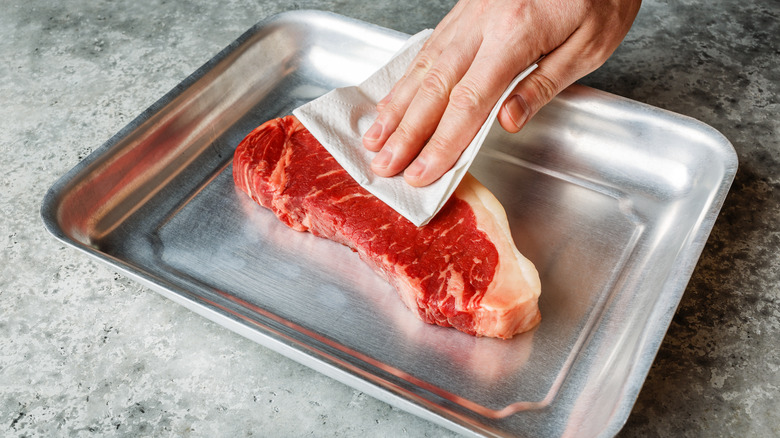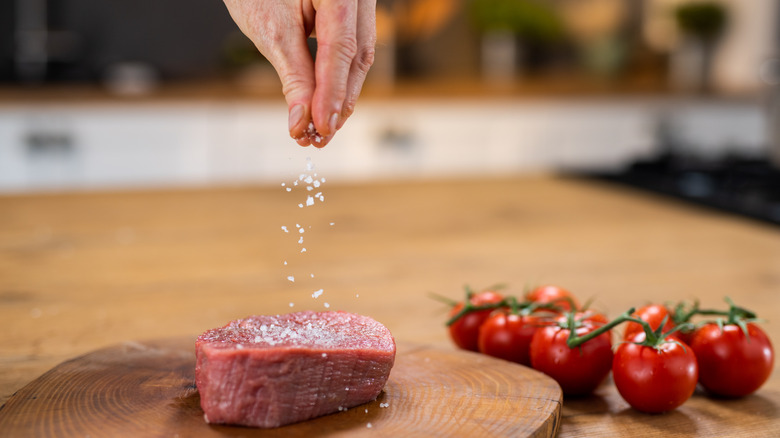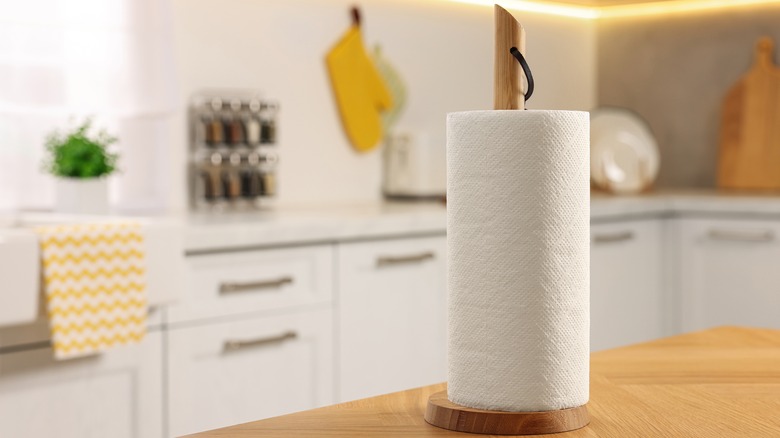Why You Need Paper Towels Every Time You Cook Meat
No kitchen is complete without a hefty roll of paper towels. On top of cleaning up spills, they can wrap up salad greens to preserve freshness, or they can be layered between pans to prevent scratches when you stack them. Even Martha Stewart uses paper towels to get rid of cooking oil. A use for this nifty product you may have never thought of, though, has to do with preparing meat. Many culinary schools teach chefs to pat down the exterior of meat with paper towels to get a perfect sear in a hot pan.
When you sear meat, it becomes browned due to the Maillard reaction, the chemical phenomenon in which amino acids and sugars caramelize under heat. Under high temperatures, these two molecules begin to interact and create a complex array of flavors and textures that we associate with perfectly browned foods — and in meats, it also creates a crispy, delectable exterior.
However, too much moisture will slow down or even prevent the Maillard reaction from occurring, as the presence of water molecules will dilute amino acids and sugars. Excess water has to evaporate for browning to occur, and if the outside of a cut of meat is wet, the whole cut can cook through and turn dry before a decent crust even starts to form. By patting down meat with a paper towel, you remove any unwanted moisture from the surface, and give yourself the best chance at getting a flavorful and crunchy exterior.
Season your meat after patting with paper towels
Even if a cut of meat doesn't look wet, you should gently press a paper towel on one side, then the other, for best results. Make sure to wear gloves and take other precautions to prevent meat juice from spreading around your kitchen. It will be worth it, as drying the surface of the meat does more than just facilitate browning. Patting excess moisture off of beef, pork, chicken, or even fish will ensure that seasonings stick to its surface better.
While a piece of packaged, unfrozen meat might seem dry at first glance, it contains both internal and external moisture that condensates over time — especially once you take it out of your fridge and let it sit on a cutting board at room temperature. Some cooks refer to this process as "sweating," and seasoning the meat without blotting will result your herbs and spices sticking to the layer of condensation, not the actual surface the meat.
You can see this happen in real time if you season a wet piece of meat in a bowl, as a good chunk of your spices will pool at the bottom of the bowl once you flip the meat over. Neglecting to properly dry or season your meat are two of the biggest mistakes you can make when cooking steak and other cuts. If you want a flavorful, crispy outer layer, don't skip out on blotting.
Use paper towels sparingly to cut down on waste
Paper towels can be a lifesaver in the kitchen, but they might not be the best choice for environmentally-conscious cooks. The U.S. Environmental Protection Agency says that paper products account for almost a quarter of the total amount of waste generated by Americans. Paper towels are by no doubt part of all that discarded trash, and there are multiple ways to cut down on your paper towel waste in the kitchen.
Washcloths and reusable towels made from absorbent materials such as cotton are the perfect, sustainable replacement for paper towels. As long as you throw them in the washing machine after every use, they can easily be used to blot the moisture of off foods.
If you're not keen on handling raw meat with reusable towels, don't worry. You can use cloth towels for many other tasks, such as cleaning up spills, drying dishes, and protecting your cookware from scratches. Meanwhile, used paper towels are compostable and can be turned into mulch for a garden or a potted plant. If you cut down your paper towel use from all the time to just now and again — such as when drying meat — your waste footprint can be reduced significantly.



